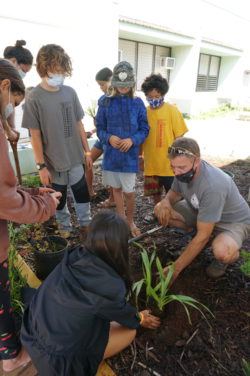Kilohana Native Garden
By Catherine Cluett Pactol | Editor

Photo by Catherine Cluett Pactol.
With fingers caked in dirt, members of Kilohana’s fifth grade class patted native plants into the ground, learning their names, their growing habits and cultural uses. The school now has a native plant garden thanks to their efforts and the support of several local organizations.
It’s a dream at least 10 years in the making, said fifth grade teacher Tammy Castor. She said the school previously planted a native garden area behind the campus but it fell prey to deer and wild pigs, along with not being cared for over summer vacations. A new garden took shape earlier this month in a courtyard plot at the heart of the school, where it will be sheltered from predators, watered by timed irrigation over the summer, and can be easily accessible and frequently admired by the entire school.
“Our goal of creating a beautiful native garden on campus to educate and inspire others is a dream come true,” said Castor. “The biggest idea is to encourage other people that this is possible and to do it in your own backyard. This has definitely sparked my interest and I’m already starting some at home.”
“Our mission here with the kids is to turn this into a learning center,” she added, describing informational plaques students will make for each plant to help their community learn about the various native species.
“It feels really fun, because we don’t always do this in class, it also takes time off from doing other work,” laughed fifth grader ‘Ala’i. “I like how it looks, it looks really nice!”
She and her classmates got a morning out of the classroom on March 2 to get their hands dirty in the garden. They shared lots of soil-encrusted high fives with each new species planted.
Penny Martin, a longtime Molokai educator with Papahana Kuaola, an aloha ʻaina-based education nonprofit, visited the classroom to talk to students about native plants prior to joining them in the task of digging and planting.

Photo by Catherine Cluett Pactol.
“Can you just imagine this little area?” she said, looking around as students pulled weeds, dug holes, gently buried plants and spread mulch. “When the lehua grows, come May Day, they won’t have to go to the forest to gather. In a sense, this is being sustainable. You have food sustainability, but now they have lei-making sustainability. Instead of going all over to gather, they’re creating their own resources.”
“There’s different colors of the ohia, my favorite is the orange,” said fifth grader Alyssa. Students don’t know what colors they’ll grow though – it’ll be a surprise!
Along with Ohia lehua, students planted Ko’oko’olau, A’ali’i, Ilie’e, Akia, Ukiuki, and a native sedge (Carex wahuensis) in the garden – provided by the Molokai Land Trust.
Butch Haase, executive director of Molokai Land Trust, donated the plants and helped prepare the garden, guiding students on planting techniques.
“We hope that this type of project helps instill an understanding of the value and importance of our native plants, and encourages a strengthening of the cultural importance and connectivity that exists between the people and the land,” said Haase. “It is through these types of efforts that the community can become more involved in helping preserve these precious resources.”
As they planted ukiuki, Haase squeezed its bright purple berries between his fingers, showing students the vibrant color inside that’s used for indigo dye.
Martin said partnerships with other Molokai organizations like Molokai Land Trust and The Nature Conservancy makes projects like this possible, along with getting keiki out into the field to experience hands on what they learn in the classroom.

Photo by Catherine Cluett Pactol.
“We like to partner up and do a better job when we share resources,” she said. “If we all come together and share our little bits of knowledge that we have, we can do something really nice, like this.”
Jowell Guerreiro, The Nature Conservancy Molokai outreach program assistant, also came out to join students as they planted.
“It’s exciting to see the younger generations engaged in perpetuating Native Hawaiian plants and learning the importance of layers in a native forest and a healthy watershed,” said Guerreiro. “These keiki understand that Native Hawaiian forests can collect a lot more water than bare ground in a non-native forest. I believe this mala is just the start of a lifelong journey to maintaining a healthy watershed within each of their own capacities.”












Don't have a Molokai Dispatch ID?
Sign up is easy. Sign up now
You must login to post a comment.
Lost Password